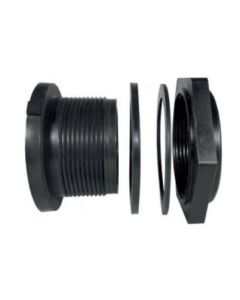In the realm of plumbing and mechanical systems, precision and reliability are paramount. Compression bulkhead fittings play a crucial role in ensuring secure and leak-proof connections between pipes and various components. These fittings are designed to handle high-pressure applications and provide robust solutions for managing fluid flow in a variety of systems. Whether in industrial machinery, water distribution networks, or residential plumbing, understanding the function and advantages of compression bulkhead fittings is essential for maintaining system integrity and performance.
What Are Compression Bulkhead Fittings?
Compression bulkhead fittings are specialized components used to connect pipes or tubes to a bulkhead or panel, which acts as a barrier or wall. They are characterized by their ability to create a tight seal around the pipe, preventing leaks and ensuring a stable connection. The design of compression bulkhead fittings typically includes a threaded nut, a compression ring or ferrule, and a sealing washer. The compression ring is pressed against the pipe when the nut is tightened, forming a secure seal that accommodates high pressure and prevents fluid from escaping. This design is particularly useful in applications where a reliable, leak-free connection is essential.
Applications of Compression Bulkhead Fittings:
Compression bulkhead fittings are versatile and can be used in a wide range of applications. In industrial settings, they are often employed in machinery and equipment to facilitate the transfer of fluids and gases while maintaining system integrity. These fittings are essential in hydraulic and pneumatic systems, where they manage high-pressure flows and ensure safety and efficiency. In water distribution systems, compression bulkhead fittings are used to connect pipes to tanks or other bulkhead-mounted components, providing a secure and durable solution for water management. Additionally, they are commonly used in marine and automotive applications, where their ability to withstand harsh environments and high pressures is crucial.
Advantages of Compression Bulkhead Fittings:
One of the primary advantages of compression bulkhead fittings is their ability to provide a strong, leak-proof connection without the need for welding or soldering. This feature simplifies the installation process and reduces the risk of errors or failures. The compression mechanism also allows for adjustments and realignments, making these fittings adaptable to various configurations and changes in system design. Additionally, compression bulkhead fittings are designed to handle high pressures and are resistant to vibration, corrosion, and temperature fluctuations. This durability ensures long-lasting performance and minimizes maintenance requirements, making them a reliable choice for demanding applications.
Installation and Maintenance:
Proper installation and maintenance of compression bulkhead fittings are critical for ensuring their optimal performance and longevity. Installation typically involves threading the fitting into the bulkhead or panel and then tightening the nut to compress the ring against the pipe. It is essential to ensure that the pipe is properly aligned and that the fitting is tightened to the recommended torque specifications to achieve a secure seal. Regular inspections should be conducted to check for any signs of wear, corrosion, or leakage. If any issues are detected, prompt maintenance or replacement of the fittings is necessary to prevent system failures and ensure continued reliability.
Conclusion:
In conclusion, compression bulkhead fittings are integral components in various plumbing and mechanical systems, offering a reliable and effective solution for connecting pipes and managing fluid flow. Their ability to provide a secure, leak-proof connection under high-pressure conditions makes them indispensable in industrial, water distribution, marine, and automotive applications. By understanding their design, applications, and advantages, as well as ensuring proper installation and maintenance, users can leverage the full benefits of compression bulkhead fittings to enhance system performance and durability. As technology and industry demands continue to evolve, the role of these fittings in maintaining efficient and reliable connections will remain essential.












































